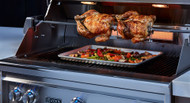HOW TO ROTISSERIE EVERYTHING
Posted by Lynx Grills on 1st Mar 2022
HOW TO ROTISSERIE EVERYTHING
December 21, 2018
First things first. Weight has nothing to do with cooking. Not on a rotisserie, not on a grill, not in the oven. Nowhere. It means nothing. The only value needed to be noted before cooking anything is its size. And because depending on the animal's natural size, and the butcher who prepared that cut for you, it is impossible to give you a truly accurate cooking guide with temperature/time based on weight. For example, a prime rib roast that is 10 inches thick, will take around four times longer to cook than one that is 5 inches thick. On the other hand, if you were to cook it based on its weight, a 10-pound roast that has been cut to a thinner longer shape, will cook much faster than a 5-pound one that was cut thicker. So focus on the size, not the weight.
If you want to know how to rotisserie anything, just skip the few next paragraphs and go to the last few lines to learn everything you need for rotisserie cooking. If you want to understand why nothing else matters, then keep reading.
Second. When you are cooking on a rotisserie, you are roasting. Roasting happens when food is placed at a certain distance from a heat source, a radiant heat to be precise. The farther away from the heat the food is, the intensity of the radiant heat lowers, and of course, the speed at which it cooks. The closer to the heat, the faster it'll cook. But be careful, this doesn't mean your food will be cooked properly. Your chicken, for example, might develop a nice golden crispy skin, but might still be undercooked inside. You will need to learn to play with the distance settings on your Lynx grill and the hood, open or closed (and for how long), in order to make sure skin and meat are done at the same time.
Bigger roasts will need to be placed further from the infrared burner on your Lynx Grill, on which you have two distance settings. But if the farthest setting doesn't work for you, due to the size of your roast, you can decide to roast it with the hood open or closed. This is a good way to regulate the heat around your food.
How do you know when your roast is done? Easy, stick an instant-read thermometer to the center of the roast and see how it's doing. Depending on what you're cooking and the result you are looking for, you will need a different inner temperature as your guidance for doneness. That's it. A good starting point would be to check the inner temperature of your roast every thirty minutes. As time goes by and you keep checking for the temperature, your culinary instinct will kick in and you'll have a better idea if it needs another thirty minutes, or twenty, or maybe even less. If you are approaching your target temperature and the outer surface of your roast isn't as brown and crispy as you'd like it, simply move your roast closer to the infrared burner and close the hood to concentrate the heat a bit more. Make sure you set a timer at this point for five minutes or so, lest you forget about it and burns. That would be a bummer.
In conclusion, to determine when your roast is done, you'll need an instant-read thermometer, like this one. Follow these temperature guidelines.
Chicken / Turkey: 165°F
Beef / Lamb: 120-125 °F (rare), 130-135 °F (medium rare), 140-145 °F (medium well), 155°F (well)
Pork: 145°F (medium well), 155°F (well)
Game Animals: 160°F
Like: Venison, Elk and Bison
Game Birds: 165 °F
Like: Grouse, Guineafowl, Partridge, Squab, Quail, Pheasant, Emu, Ostrich, Wild Ducks, Wild Geese, Wild turkey, etc.
Keep in mind, cooking is a skill that needs to be practiced and perfected, especially when it comes to roasting as there are more variables to take into consideration. So practice, practice, and practice just a bit more.
Andres Dangond
Executive Chef & Director of Culinary Development
Lynx Grills

